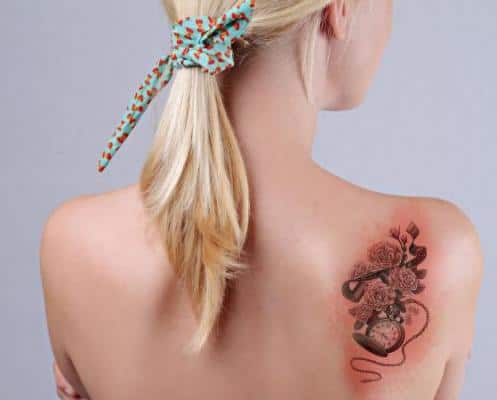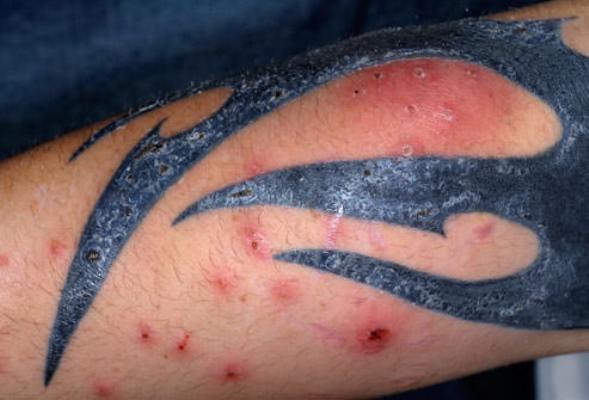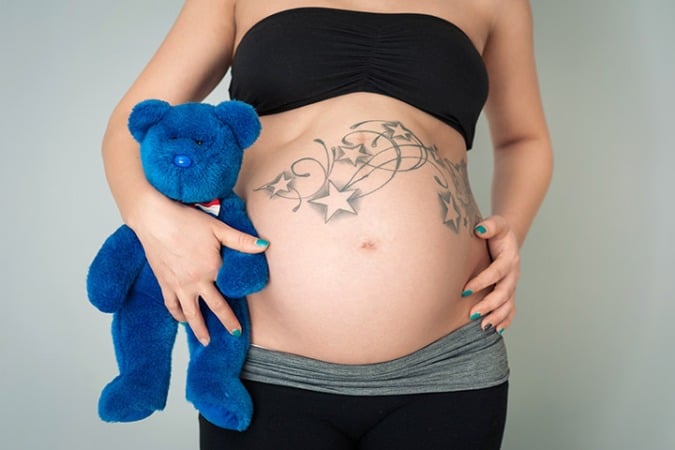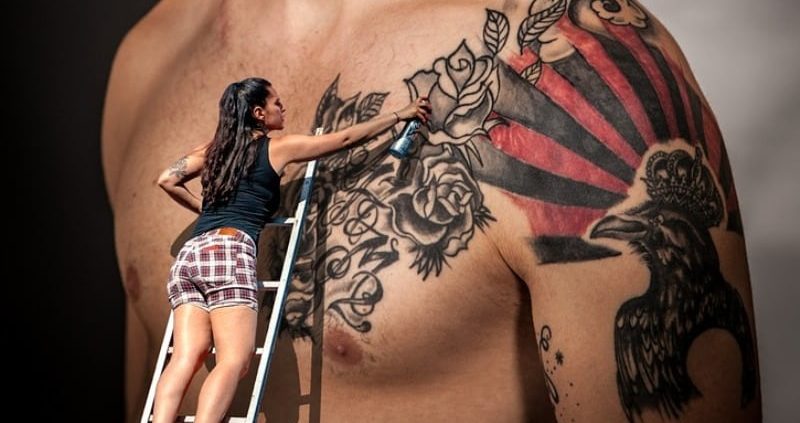Your recently done inking on your body goes wrong.Don’t worry discover how you can cure an infected tattoo here.
Decorative tattooing has been in fashion for thousands of years. In many ancient cultures, tattoos were a symbol to distinguish social status. Although this trend remains to the present day in few cultures.
However, tattooing has now evolved as a raging fade among everyday people of western countries in the last decade or so.
But with the increase in some people getting tattoos, there is also a rise in numbers of tattoo-related skin disorders.
Table of Contents
But Why Does Tattooing Cause Problems

Tattoo artists use equipment like dental drills to inject ink into your skin. The entry of foreign substances into your skin can cause a noxious or immunologic response.
The tattoo pigment can even cause infectious diseases. Some skin disease within the tattoo or around include -cellulitis, impetigo, herpes simplex, fungal infection, syphilis and viral warts, etc.
Chances of catching Hepatitis C (a fatal liver disease) and HIV/AIDS are high if the tattoo shop uses contaminated needles.
When To Ask For Help?
New tattoos will be prickly and painful and as sore as a sunburn. Also, during the first two days of getting a tattoo, it can be very tricky to ascertain whether you have an infection or not. So don’t be in haste. Follow a proper tattoo aftercare regimen.
Symptoms of A Tattoo Infection

1. Inflammation
It is not unusual to have some inflammation after a fresh tattoo. But even after a couple of days, it’s spreading over then your skin may be contaminated.
Inflammation can cause itching / irritating pink or reddish discoloration around your tattoo. This area on your skin will become slightly warm to touch. And if this heat appears to spread around, it may be a dangerous sign of a developing problem
2. Pain
It is normal to experience little pain after getting a tattoo. But continuous stinging sensation for a long period can be a sign of infection.
3. Swelling
You can expect a light amount of swelling after getting a new tattoo which is normal. But if swelling causes high discomfort or is spreading beyond the site of the tattoo, then it might point towards an infection. In such cases get immediate medical help.
4. Discharge
All fresh tattoos can ooze a clear liquid as an act of skin recover. This liquid usually dries up later.
So you should seek medical help when-
i) Discharge doesn’t stop even after 48 hours
ii) If tattoo area begins to secrete yellow or greenish pus
5. Foul Odor
Anaerobic bacteria on your skin will cause a foul smell. If your tattoo begins to smell bad, visit your dermatologist to check for any infections.
6. Fever
Fever has always been a warning sign of an underlying infection. It is common among people who are stressed and not in good health. So it’s best to observe first and not to jump conclusions. Seek medical attention if fever won’t go away after two days.
7. Red Streaks
Red streaks radiating beyond the original tattoo site could imply blood poisoning. In such cases, seek urgent medical help because it left untreated, it will be fatal.
8. Swollen Lymph Nodes
Lymph nodes swelling implies that the immune system is fighting an infection. Hence, examine lymph nodes closest to the tattoo for swelling for a few days after getting a tattoo. If you notice any change, contact your doctor.
Causes Of Tattoo Infection
From several different causative factors of tattoo infection, some are listed below:
- Poor hygiene and improper maintenance of your tattoo.
- The tattoo artist uses unclean or contaminated needles.
- The equipment at the tattoo parlor is not adequately sterilized.
- Your clothes could be rubbing against your tattoo and irritating it.
- Not cleaning or washing the tattoo site properly.
- Swimming with a freshly done tattoo especially in muddy ponds or lakes.
- Sleeping on unsanitary sheets and using dirty towels.
- Touching your tattoo using dirty fingers.
- Not following proper aftercare instructions.
- Using strong chemical lotions creams or makeup products.
Treatment Of An Infected Tattoo
i) Consult a dermatologist or doctor if you notice above mentioned signs. Your doctor will prescribe you with antibiotics to combat the infection.
As soon as possible start using those antibiotics as directed by your doctor. This will help you to ward off the infection.
Most tattoo skin infections are easy to fight, but blood infections can be tricky. Such infection needs to be immediately treated.
ii) Apply a topical medication or ointment if given, as directed by the doctor. Afterward, dab the topical ointment on your tattoo and keep the tattoo as clean as possible.
iii) Wash the tattoo area gently with clean water two times a day and follow your doctor’s instructions.
iv) Put the nonstick bandage with some ointment onto it but if the skin under the bandage starts to itch, wash off the ointment and don’t use that ointment again. Change and apply a clean bandage daily.
But if your bandage sticks to the affected area-
- soak the bandage in water or
- strip the bandage off under running water in the shower.
Do’s And Dont’s
i) After treatment, you should keep the tattoo covered with sterile gauze. The open wound heals faster than the wounds closed by bandages. So you should expose your tattoo to fresh air to heal faster but to a safer extent. Also change your gauze regularly.
ii) While sleeping be careful not to let the infected area stick to your bedding. Try to keep the tattoo dry until the time the infection heals. Wash your tattoo regularly with non-scented soap and clean water. Dab the area till it’s dry.
iii) Do not swim with an infected tattoo of chlorine in swimming pools can harm your skin. Also, cover your tattoo while taking a shower.
iv) Avoid use of any chemical based products like soaps, makeup, etc. Such products will only aggravate your infection.
v) To achieve instant relief from bruising, swelling, or itching applies the ice pack. Avoid applying ice directly on your infection site. Always maintain a layer of fabric between your skin and the ice. Since the direct application may cause tissue damage.
But for a permanent solution, take an antihistamine such as Benadryl or Chlor-Trimeton. This treatment will provide relief from hives and itching.
How To Prevent Tattoo Infections?
Many people because of their fear of infection avoid getting tattoos. Even though infections are curable and only a handful of people suffer from it. But if you still like to cut down the risks of infections,
Follow the below-mentioned precautions –
- Only get your tattoos from certified and trained tattoo artists.
- Make sure your selected parlors have a proper license.
- Make sure your selected professional artists have a proper license and satisfactory track record.
- Ensure that your tattoo artist uses new sterile needles.
- Strictly follow the instructions the tattoo artist gives you about aftercare.
- Wash gently with warm soapy water and dry the area.
- Never use Neosporin or Vaseline on new tattoos.
- Let your tattoo receive enough air as it heals.
- Avoid wearing clothing that might irritate or chafe the area around the tattoo
- Keep tattoo area out of sunlight as much as possible to avoid bleeding of the ink.
What Happens After The Infection Is Cured?
In the worst case scenario, people develop scar tissue, and the color and design of their tattoos start to fade away.
Allergic Reactions To Tattoos
A tattoo allergy can be of various types:
1. Acute Inflammatory Allergic Reaction
It’s not a serious condition and subsides on its own in a couple of weeks. At the tattoo site, your skin becomes red, irritated and slightly swollen. This occurs due to irritation caused by the tattoo ink and needle.
2. Photosensitivity
Allergic reaction trigger by sunlight is photosensitivity. Especially tattoos which contain yellow tattoo ink are photosensitive. Yellow and red tattoo dyes contain cadmium sulfide responsible for this immune response.
3. Dermatitis
Photoallergic and allergic contact dermatitis can occur. In general mercury sulfide present in red tattoo pigment causes this response.
4. Lichenoid Allergic Reaction
This is a rare allergic reaction. This reaction causes small bumps to appear around the tattoo site. It is common for the usage of red tattoo pigment.
5. Pseudolymphomatous Allergic Reaction
Like the above-mentioned allergies, it causes sensitivity to tattoo ink. Red tattoo ink is usually the main culprit, but blue and green inks may trigger it too sometimes. But the major difference is that it is a delay reaction.
6. Granulomas
These types of reaction show occasional tiny bumps. Red tattoo ink is usually the main factor, but blue, green, purple inks may also trigger it sometimes.
Signs Of An Allergic Reaction
To avoid such discomfort, it’s best to get an allergy test performed before getting a tattoo.
Normally, black ink doesn’t contain any harmful substances. So hardly any people are allergic to it. While colored inks can trigger your immune response due to an extra chemical additive.
Allergic reaction manifestation differs according to person’s skin and the tattoo pigment used.
For an allergic reaction to a tattoo few signs observed include:
- Swelling
- Rash and bumps
- Redness
- Skin has a scaly appearance
- Flaking
- Purplish or reddish nodules around the site of tattoo
Treating Allergic Reaction To Tattoo Ink
Tattoo allergies are comparatively minor than tattoo infections. So they do not need emergency medical aid. Self-administration of a soothing agent such as aloe vera can help to reduce the discomfort.
But for severe allergic reactions, Benadryl can be used, or any skin medications prescribed by a doctor or dermatologist. Topical steroids can also relieve inflammation.
Sometimes, anaphylactic shock (severe immune attack) can occur. In such cases, seek medical help immediately.
In some conditions, tattoo removal may become necessary but never try to remove the tattoo yourself. Always find a well-reputed dermatologist or cosmetic surgery center to perform laser tattoo removal and ensure that they provide proper care and treatment.
You can use nonprescription medicine such as acetaminophen (Tylenol), NSAIDs like Ibuprofen, Advil, Asprin, etc. for your pain
You can use nonprescription medicine such as acetaminophen (Tylenol), NSAIDs like Ibuprofen, Advil, Asprin, etc. for your pain
● Carefully read all directions on the label
● Do not take more than the recommended dose and do not take medicine if you are allergic to it.
● If you are pregnant, consult your doctor before taking them.
But follow these instructions before using such medications:
What To Expect During Laser Tattoo Removal?
The number of sessions of tattoo removal varies according to size and color of your tattoo.
Removal time of allergic tattoo varies depending on the patient’s age, size, the color of skin and type of tattoo and the pigments used in it.
During an office visit for tattoo removal you may experience the following:
- The doctor will place protective shields on your eyes.
- Your skin will be examined under various intensities of a laser.
- After deciding on the intensity, a handpiece is placed against the surface of your skin, and the laser light is switched on.
- Laser pulse may feel like a grease spatter or the striking of a rubber band against your skin.
- Some pulses required varies according to the area. Small tattoos require lesser pulses, and larger ones require more.
- Immediately after laser treatment, an ice pack is applied to soothe the affected area.
- You will experience this every time you visit the center, and you may require multiple visits.
- After each session, you will see your tattoo progressively becoming lighter.
- Your doctor may give you topical antibiotic cream or ointment.
- Place a bandage on your tattoo to shield it from the sun. After the removal of your bandage, apply sunblock for extra protection.
- Depending on the site of the tattoo and intensity of pain, the dermatologist may give you some topical anesthetic or painkiller injection.
Possible Side Effects & Risks Associated With Laser Tattoo Removal
No action is without any consequences, not even tattoo removal. But these side effects in the majority of cases is insignificant-
- The tattoo removal make site may become prone to infection
- You might end up with a permanent scar.
- You can be prone to hypopigmentation (lighter skin appearance) or hyperpigmentation (darker skin appearance).
- Cosmetic tattoos like eyeliner, lip liner, and eyebrows may darken after treatment with tattoo removal lasers.
- All those procedures can cause fading of tattoos.
Difference Between Tattoo Infection & Tattoo Allergy
Treatment varies according to the condition. Thus it is important to diagnose whether you have an infection or allergy.
Below table highlights some key points to distinguish between the two.
Subsidies quickly than infection.
Antihistamines are used for treatment.laser removal is required in a major amount of cases.
Tattoo Infection |
Tattoo Allergy |
| Persist for a long time. | |
| Fluid discharge, fever, swollen lymph nodes are observed | No fluid discharge, fever or swollen lymph nodes are seen. |
| Antibiotics are the choice of treatment. | |
| Laser removal is not required. | |
| Sunlight has no major effect on it. | Sunlight will aggravate the allergic condition. |
| External factors and unhygienic conditions play a greater role. | Patient’s sensitivity to ink plays the major role. |
Risks Of Getting Tattoos While Pregnant

1. Infection
The tattoo ink won’t enter your bloodstream, but there is a risk of infection. For, eg, Any time you get injected with an unhygienic needle there is a chance of contracting hepatitis or HIV.
2. Epidural
It is a rare occurrence, but for gynecologists and anesthesiologists, it is a concern that the epidural needle could push the pigmented tissue into the spinal cord and trigger some infection.
3. Stretch marks
A new tattoo that looks shapely on your 15-week pregnant skin might become distorted or lopsided after you regain your pre-pregnancy figure.
Are There Any Skin Cancer Risks Associated With Tattoos?
There is no significant study done which will either prove or deny cancer risks associated with tattoos, but it is never a good idea, to have a tattoo surrounding or within a mole.
It is especially crucial for people suffering from the plastic nevus (atypical mole) syndrome. There is a considerable risk of developing skin cancer within moles. So make sure you placed your tattoo far from any mole.
Is It Safe To Get An MRI Scan With A Tattoo?
Magnetic Resonance Imaging (MRI) machines are used to located tumors and other abnormal growths within the body. People with tattoos are known to experience swelling or burning sensation in the tattooed areas during MRI. Though this rarely occurs and without any lasting effects.
There have also been cases of tattoo inks interfering with the quality of an MRI image. The reason for this is not yet fully determined, but it is also believed to take place because of an interaction between metallic components of machines and tattoo pigments.
The dye used in red tattoo pigments contains iron which is very vulnerable to the magnetic fields used in MRI machines. The metal gets hot enough to burn you, but the probability of this is very rare.
If your tattoo is looped shaped, it can act as an antenna for magnetic fields and can cause ink pigments to pick up the more magnetic frequency. The will result in inflammation and swelling of the tattooed skin, and your skin can feel hot and irritated.
Tattoos present around or near eyes are very sensitive to surplus heat also consult with your doctor and MRI technician about possible burn risks and take the necessary precautions.
Final Talk
So here are a few things you should consider before inking your body:
i) Always get a tattoo after doing research and hunt out a well-reputed tattoo parlor.
ii) Make sure that you receive your tattoo with sterilized equipment under proper hygienic condition.
iii) Make sure your tattoo artist wears disposable gloves. Do not compromise on your well-being or health.
iv) If a tattoo starts to irritate your skin, look for signs of possible infection. Such as foul smell, fluid discharge, swelling, pain, red lesions, fever. Seek medical aid at once.
v) Apply antibiotic prescribed by your dermatologist with a bandage on your affected areas.
vi) In the case of an allergic reaction, seek medical aid at once.
vii) During pregnancy, avoid getting your back tattooed if you wish to opt for epidural anesthesia during delivery.
viii) MRI scan with a tattoo may cause burns. This incident is extremely rare, but still inform your doctor or radiologist beforehand and take necessary precautions.
Overall, it is safe to get a tattoo if you get it under a sterile environment and hygienic conditions. But if symptoms of infection or allergic reaction starts to appear, get immediate medical help.
Also Read:
Inner Lip Tattoo : Things You Should Know Before You Have It
141 Awesome Feminine Tattoos For Girls Which Will Blow Your Mind





